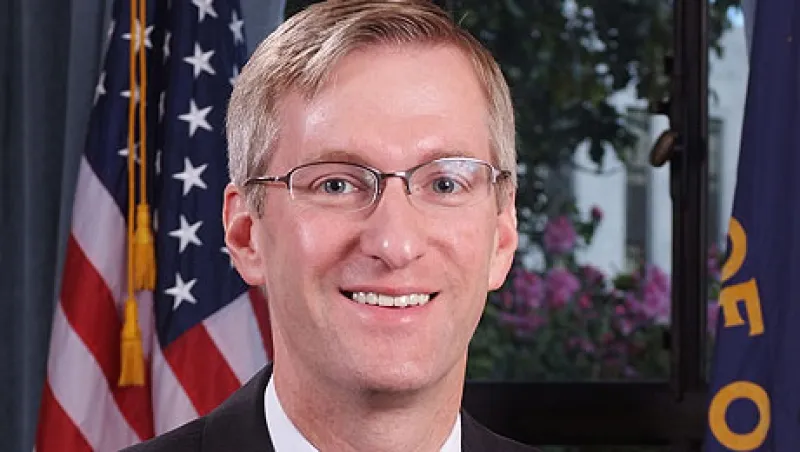Over the past three years Oregon State Treasurer Ted Wheeler has emerged as a champion of efforts to preserve the defined benefit retirement system. Considering that he’s charged with overseeing management of the state’s $64 billion pension fund, that’s hardly surprising. But Wheeler’s ambitions extend much farther than protecting the benefits of public sector workers. He is leading efforts to find innovative ways of providing retirement security to a large segment of the private sector workforce that currently enjoys no pension benefits.
In May Wheeler backed a measure to establish a task force to review pension possibilities for private sector workers. The issue is not on the radar screen of most state treasurers, but Oregon has a large number of small businesses and start-ups, many of which offer no pension plans to employees. The bill was approved by the legislature and signed into law by Governor John Kitzhaber in August. A key to winning support for the bill was the insertion of an amendment stipulating that any private sector pension solution not “create any financial obligation, liability, or guarantee on the part of private sector employers.” The seven members of the task force are due to be announced shortly; Wheeler will either serve as a member of the task force or appoint a designee.
The body is supposed to present its ideas to the legislature in September 2014 and will continue its work until January 2017. “We have been asked to propose some broad guidelines,” says the treasurer, for how a private sector solution might work. “We are not at the answer stage yet.”
Wheeler, 51, has also been working to shore up the state’s existing public pension system. He made pension reform a cornerstone issue of his 2012 election campaign, proposing to cap cost-of-living increases and eliminate a tax rule that effectively rewards retirees who move outside the state. He also suggested lowering the system’s assumed 8 percent rate of return, even though this would increase the state’s $13.2 billion unfunded pension liability, and he pledged — as a member of the $82 billion Oregon Investment Council, which oversees the pension fund and other state assets — to reduce costs and improve risk management.
Keeping true to his word, in January Wheeler proposed an investment modernization bill that would transform the pension fund by giving the OIC more autonomy and resources to manage the fund, which the treasurer regards as key to bringing down costs. The proposed model is similar to that used by Canada’s main public pension funds, most notably the C$129 billion ($121 billion) Ontario Teachers’ Pension Plan. Currently the state pays about 78 cents in management fees for every $100 in assets and manages only 19 percent of those assets in-house. The state of Washington, which manages about 30 percent of its $91.4 billion in assets in-house, pays some 68 cents per $100 in fees, whereas Wisconsin, which manages approximately 58 percent of its $94.4 billion itself, pays 38 cents.
The bill did not make it to the floor of the legislature this year. It will, however, be resubmitted in 2014, and OIC chair Keith Larson has said he has received assurances it would be voted upon then. A managing director with Intel Capital, the venture capital arm of the semiconductor maker, Larson believes the reforms are essential to the future of the pension system, and he lauds Wheeler for supporting them, even though the changes would curb the treasurer’s power. “This is one of those rare opportunities where you have someone in political office who is willing to do the right thing, even if it is somewhat to his detriment,” says Larson. “That is a huge positive.”
Other parts of Wheeler’s agenda have made progress. In a special session called by the governor in October, the legislature passed a bill that eliminates tax benefits for out-of-state retirees; reduces cost-of-living adjustments for retirees by as much as 75 basis points, to as low as 1.25 percent for some retirees; and caps the COLA at 1.5 percent, down from 2 percent. The Public Employees Retirement System board, a five-person body that has responsibility for managing the liabilities of the retirement fund, also took steps to lower its assumed rate of return to 7.75 percent. The net effect of the changes reduced the pension system’s unfunded liability from $13.2 billion to $11.1 billion.
Wheeler’s work on pension reform, both public and private, earned him a slot — at No. 20 — on Institutional Investor’s inaugural ranking of the 40 most important people in the defined benefit pension reform debate. The Oregon native has an undergraduate degree in economics from Stanford University, an MBA from Columbia University and a master’s in public policy from Harvard University. He spoke recently with Institutional Investor Senior Writer Imogen Rose-Smith about his pension objectives:
Institutional Investor: Why were those two bills — to establish a retirement savings task force and the investment modernization bill — so important?
Wheeler: They are important for different reasons. Reforming the investment management function of the state of Oregon is important because we have had the same structure in place since the 1970s. Back then we had $1 billion, all in fixed income; today we have over $82 billion invested globally across almost every investment class, and the market is getting more complicated. The Investment Modernization Act seeks to allow us to better manage our investments in the current environment. The retirement security program is an acknowledgment that we have got an upcoming demographic problem. About half of the Oregonians employed in the private sector do not have any form of retirement. Generation Xers in this state have some of the lowest retirement saving rates in modern history. Over the next ten years the number of retirees is expected to balloon. What is seen today as being a personal matter is rapidly becoming an issue for all of us.
You have said that the Investment Modernization Act could result in significant cost savings for the state. How so?
The way we are currently organized requires us to outsource a lot of the functions, such as back-office and risk management services. By insourcing some fairly basic analytic jobs that we are currently paying a lot of money to Wall Street for, we could save about $22 million in fees a year. Some have suggested eventual savings of $100 million a year. If you accrue those savings over 20 years, that becomes a huge savings: $2.7 billion, to be exact.
So are the cost savings the main motivation behind your support for the bill?
The main reason we are doing this is, we have to be able to better manage our portfolio. Not only do we need to be able to assess risk by insourcing; we also need to be able to give the Oregon Investment Council the latitude to be able to hire the people they need to hire and give them the license to put in the systems they need to manage an $82 billion investment portfolio. The treasury is viewed as being just another public agency, but we are close to being a private sector enterprise in that we compete head to head with Wall Street, and we need the resources to be able to compete.
Is this a form of privatization?
No. What we are seeking to do is establish the OIC as its own agency, giving the OIC a leadership position over the treasury staff that advises them and empowering the OIC to bring in potential investment staff. There would still be a tremendous amount of public oversight.
What are some of the pension governance arrangements you see out there that provide a model for how the OIC could operate?
The Canadian pension funds have been way ahead of the U.S. pension funds in terms of governance models. The state of Wisconsin has a model very similar to what we are trying to create in Oregon.
The proposals in the Investment Modernization Act have similarities to what officials overseeing the $45 billion New York City pension system have tried to do. Their effort failed. What makes you feel Oregon will be more likely to succeed?
Because other people have failed is in no way a distraction to me in terms of doing what we need to do. I don’t care if other people have tried and failed. My job is to do what I think is right for the state of Oregon.
Who loses power if these reforms are enacted?
The only person who loses authority under this new model would be me. As treasurer, I want to make sure we are managing our portfolio as effectively as possible. What we would get is a model that would give us much better performance and much better risk management. As an elected official, I am more than prepared to trade off a little bit of power in exchange for something that is in the best interest of the state of Oregon in the long term.
How much of the active investment management function would be moved in-house?
The vast majority of the portfolio will continue to be managed by the money center banks and investment firms; that will always be the case. As an institution, we gravitate toward investing with the top funds, and those funds will always be based in the money centers around the world. Our objective is not to insource the high-value asset management that we have in place. We cannot replicate that.
What is the intent behind establishing the retirement savings task force?
When we look at the demographics in the state of Oregon, we are concerned. We are working with a broad range of stakeholders in the business community — the financial services industry, the general public, as well as people in my office — to see if we can find some new retirement options for the private sector.
If sounds very similar in concept to the Secure Choice Retirement Savings Trust Act, which the California legislature passed last year. Is it?
There is at least one significant difference in that there will not be a mandate solution. The task force will study the options, but we need to find solutions that do not saddle the state or the private sector with additional liabilities and that still provide low-cost, portable and voluntary participation for Oregonians. We have some basic ideas, but it is a two-year process to work with the stakeholders.
Who is most in need of a new retirement option?
When we look at who in Oregon works in the private sector but does not have access to a retirement plan, it is largely single women heads of households, minorities and people who work for small businesses. If we can start to identify who is not being included in the current retirement security universe, it starts to give us some idea of what strategies we might be able to employ to help solve the problem.






